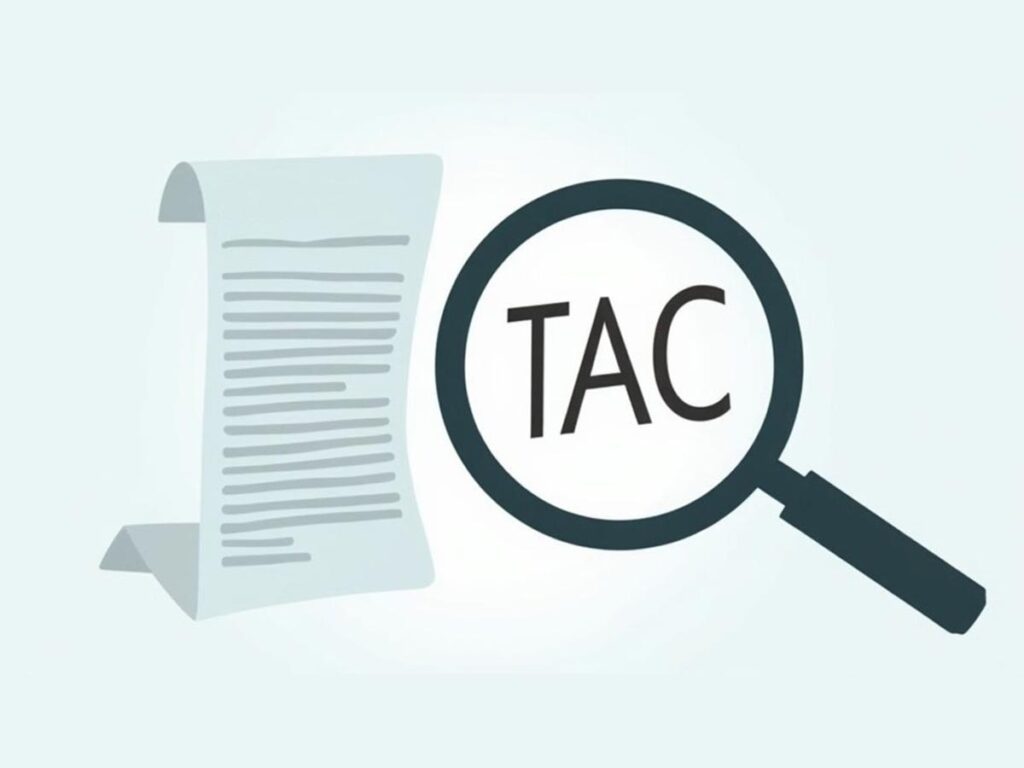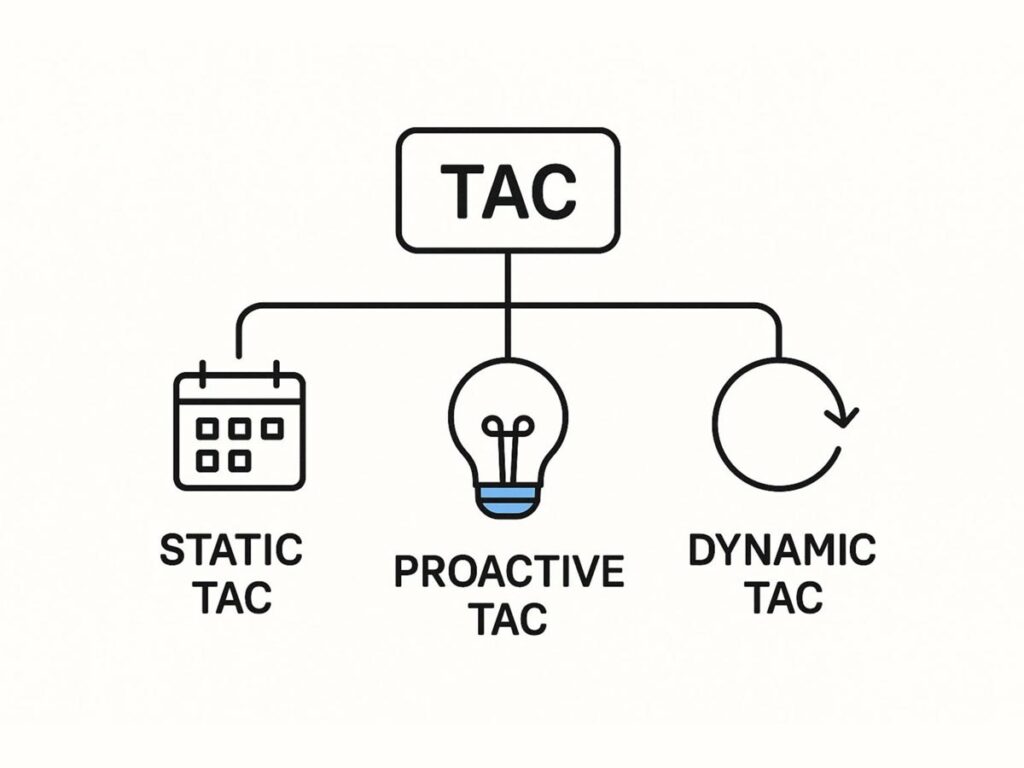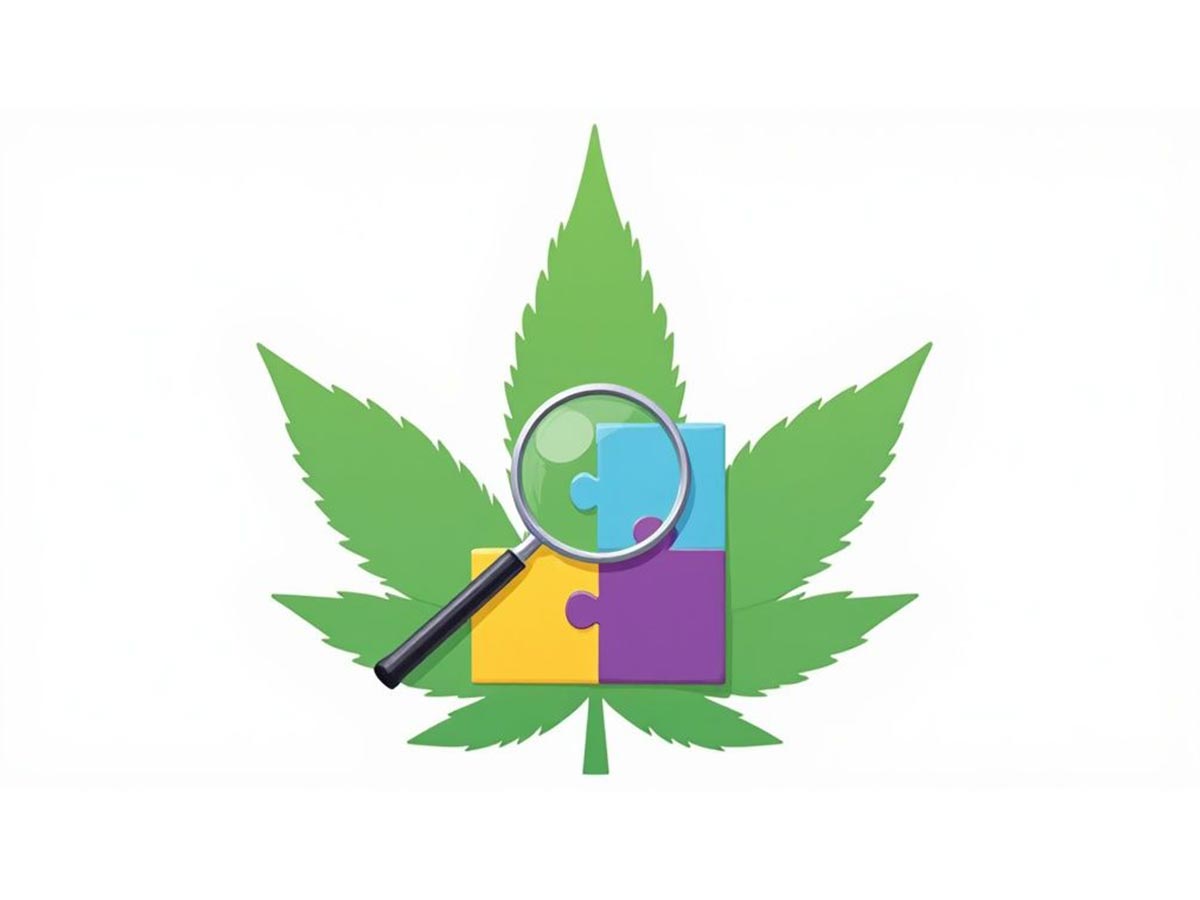Ever glanced at a cannabis label, seen a bunch of numbers, and wondered, “What is TAC?” You’re not alone. The simple answer is that TAC stands for Total Active Cannabinoids. It’s the full-spectrum measurement of all the active compounds working together in a product—not just the THC. Think of it as the ultimate preview of the true experience you can expect, helping you choose products with confidence.
Your Quick Guide to Understanding TAC

When you’re shopping for cannabis, the number that screams for attention is almost always the THC percentage. For years, that was the primary metric for potency. But focusing only on THC is like judging an orchestra by its lead violinist—you miss the rich, complex sound of the entire ensemble.
This is where understanding TAC becomes your secret weapon for a better cannabis experience. TAC, or Total Active Cannabinoids, measures the combined strength of all the beneficial compounds in the plant that are “activated” by heat in a process called decarboxylation.
TAC offers a more complete, holistic picture of a product’s potential effects. It includes not only THC but also other key players like CBD, CBG, and CBN. Each cannabinoid brings a unique skill to the team, shaping your overall experience.
Thinking in terms of TAC helps you move beyond the simplistic question of “how strong is it?” and start asking a much more useful one: “what kind of experience will this give me?”
THC vs. TAC at a Glance
So, what’s the real-world difference between these two numbers on your label? While THC content tells a crucial part of the story, TAC gives you the complete narrative. Looking at both helps you make a far more informed decision.
Here’s a practical breakdown of what each metric reveals.
| Metric | What It Measures | What It Tells You (Your Actionable Insight) |
|---|---|---|
| Total THC | The total amount of activated THC (Delta-9 THC) and its raw form, THCA. | The primary psychoactive intensity of the product. |
| Total Active Cannabinoids (TAC) | The sum of all activated cannabinoids, including THC, CBD, CBG, CBN, and others. | The complete chemical profile and a better predictor of the overall effects and experience. |
Basically, THC gives you the headline, while TAC provides the full story. This knowledge empowers you to find products that deliver the specific effects you’re actually looking for.
Meet the Cannabinoids Inside TAC
When you see the TAC value on a label, you’re not just looking at a single number. Think of it as the lineup for a team of active compounds, each bringing its own special talent to the game. Getting to know these players gives you an insider’s view of what the product is made of and how it’s likely to make you feel.
Of course, the star player is almost always THC (Tetrahydrocannabinol). As the most famous cannabinoid, it’s responsible for the primary psychoactive “high” that cannabis is known for. This is what most people are referring to when they talk about a product’s potency.
Right alongside THC is CBD (Cannabidiol), which has earned a stellar reputation for being non-intoxicating. People often turn to CBD for its reported calming and balancing effects, making it an invaluable teammate. A product with both THC and CBD can offer a completely different, often more grounded experience than one that’s THC-only.
The Supporting Cast of Cannabinoids
Beyond the two headliners, TAC includes a whole crew of “minor” cannabinoids that play crucial supporting roles. They might not be in the spotlight, but they add incredible depth and nuance to the experience.
- CBG (Cannabigerol): Often called the “mother cannabinoid” because other cannabinoids are synthesized from it. CBG is gaining serious attention for its potential to promote focus and provide an uplifting feeling without the jitters.
- CBN (Cannabinol): This cannabinoid becomes more prominent as THC ages. It’s frequently associated with relaxing or even sedating effects, which is why it’s a popular choice for winding down at the end of the day.
- CBC (Cannabichromene): While research is still emerging, CBC is believed to be a fantastic team player, working synergistically with other cannabinoids to enhance their overall benefits.
The TAC test is all about measuring this complete lineup. When these compounds work in concert, they can influence how THC feels, leading to a much different experience than you’d get from THC alone. This powerful synergy is what experts call the ‘entourage effect.’
It’s also worth noting what isn’t part of the TAC calculation. Terpenes, the aromatic compounds that give a strain its unique scent and flavor, are measured separately. While they are a massive part of the overall experience, they don’t count toward the TAC number itself.
Exploring different cannabinoid profiles can unlock a new world of products you’ll love. For a deep dive into how these compounds appear in concentrates, check out our guide on the best THCA hash rosin carts.
Understanding the Entourage Effect
Have you ever tried two cannabis products with the exact same THC percentage, only to find they affected you in completely different ways? That’s not a fluke—it’s a fascinating phenomenon known as the entourage effect. This is where understanding TAC becomes truly powerful.
Think of it like a symphony orchestra. THC is the powerful brass section, bold and impossible to ignore. But the music wouldn’t be nearly as rich or moving without the strings (CBD), the woodwinds (CBG), and the percussion (CBN). Sure, the brass section can play alone, but the sound is one-dimensional. When the whole orchestra plays together, you get a lush, complex, and far more profound experience. That’s precisely how the compounds in cannabis work together.
The entourage effect is the scientific theory that all the different compounds in cannabis—cannabinoids, terpenes, and flavonoids—work in synergy to produce a superior result than any single compound could achieve on its own. THC may grab the headlines, but the minor players are critical in sculpting the overall feeling. This synergy is why looking at the full chemical profile, including TAC and terpene content, gives you a much clearer map of what to expect than just the THC number alone. You can learn more about this powerful interaction and why it’s so important for modern consumers.
This image helps visualize how different compounds come together to create the total effect.

As you can see, the final experience is a cocktail of multiple ingredients, not just a single active compound.
Why TAC Is a Better Guide
Shopping for cannabis based only on THC content is like judging a gourmet meal by its main ingredient. Knowing it’s salmon doesn’t tell you if the dish is spicy, savory, or smoked. The herbs, spices, and sauces are what truly define the culinary experience.
In the same way, a product’s TAC reveals the full “recipe.”
- A product with very high THC and little else might feel one-dimensional and can sometimes be jarring or “racy.”
- In contrast, a product with a more balanced TAC that includes CBD or CBN could provide a smoother, more layered experience, even if the THC percentage is lower.
By looking at the TAC, you’re getting a preview of the entire orchestra’s performance, not just the brass section’s solo. It empowers you to choose products that are more likely to deliver the well-rounded, enjoyable experience you’re truly seeking.
How to Read Cannabis Labels Like a Pro
Alright, you’ve mastered the theory. You know what TAC is. Now for the practical application: using this knowledge when you’re standing in front of a shelf of products. Let’s break down how to read a cannabis label with the confidence of an expert.
First, locate the potency panel on the packaging. This is your treasure map. It’s usually a small sticker or a printed box that lists the cannabinoid percentages and tells the true story of what’s inside.
Finding and Interpreting TAC
Once you’ve found the potency information, scan for the TAC value. It might be clearly labeled as “Total Active Cannabinoids,” or sometimes just “Total Cannabinoids.” This number is your starting point—it tells you the combined strength of every active ingredient, not just THC.
Here’s a great example of what a typical label looks like.
Notice how the TAC is listed at 23.58%? Right below it, the Total THC is 20.33%. That 3.25% gap between the two numbers is filled by all the other fascinating compounds, like CBD and CBG, which are responsible for shaping and refining the overall experience.
So, how do you use this in the real world? It’s a simple, actionable process.
- Step 1: Find the Numbers. Pick up the package and locate the cannabinoid breakdown.
- Step 2: Spot the TAC. Find the total percentage or milligram count.
- Step 3: Compare TAC and THC. Note the difference. A larger gap often suggests a more complex, well-rounded effect.
- Step 4: Look for the supporting cast. Are there specific percentages for CBD, CBG, or CBN? These are your clues to the product’s likely effects.
By making this a habit, you start making choices based on the complete picture, not just a single metric. It’s the difference between picking a wine based only on its alcohol content versus considering the grape, region, and tasting notes.
If you want to see how this applies to different product types, our cannabis concentrates guide offers more examples that dive even deeper.
How to Use TAC to Find the Right Product for You
Now that you know what TAC is, you can stop chasing the highest THC number and start shopping with intention. Your newfound knowledge is a tool that helps you match a product’s cannabinoid profile to the experience you desire. It’s all about making TAC work for you.
Many people fall into the trap of believing that more THC always equals a better time. However, a product with sky-high THC and nothing else can sometimes feel one-dimensional or even edgy. A more balanced TAC often creates a richer, more enjoyable, and more predictable effect.
Match the Cannabinoids to Your Needs
Instead of just glancing at the big THC number, take a moment to look at the supporting cannabinoids on the label. Their presence is a massive clue about what the product is designed to do, giving you unprecedented control over your experience.
First, ask yourself a simple question: what am I trying to achieve?
- Looking to Relax? If your goal is to melt away the stress of a long day, seek out a product with a good TAC that also lists CBN. This cannabinoid is gaining significant attention for its relaxing properties, making it a go-to for evening use.
- Need to Focus? For times when you need a clear head and a gentle lift, a product featuring CBG could be your perfect match. People are exploring CBG for its potential to boost alertness without the anxious buzz that some high-THC strains can produce.
Beyond the total number, the specific breakdown of cannabinoids gives you the inside scoop. For example, Cannabigerol (CBG) is often called the ‘mother of all cannabinoids’ because it is the precursor to both THC and CBD. Then there’s Cannabinol (CBN), which forms as THC ages and is frequently associated with sleepy, sedative feelings. By examining this detailed breakdown, you can align a product with your real-world goals. You can find more details on how these compounds compare over at Forbes.com.
This strategic approach transforms shopping from a guessing game into a smart, deliberate choice. You can start exploring different products—like those in our quick guide to CBD and THC tinctures—and see firsthand how different cannabinoid combinations create entirely unique outcomes. When you understand what each cannabinoid brings to the table, you can sidestep unwanted effects and discover new favorites that feel custom-made for you.
Got Questions About TAC? We’ve Got Answers.
As you start getting familiar with TAC, a few questions always seem to pop up. Let’s tackle them head-on so you can feel confident decoding those cannabis labels.
Is a Higher TAC Always Better?
Not at all. Think of it like coffee—the one with the most caffeine isn’t always the “best.” The right product is the one that fits your personal goals and tolerance.
For someone new to cannabis, a product with a sky-high TAC could easily be overwhelming. You might find that a more balanced profile—with moderate THC and a healthy mix of other cannabinoids like CBD—delivers a far more enjoyable and manageable experience. The goal is to find the right combination for you, not just chase the biggest number.
Does TAC Include Terpenes?
That’s an excellent question, and the answer is no. TAC only measures cannabinoids.
Terpenes are a separate class of aromatic compounds. They create the unique scents and flavors in cannabis—the citrusy notes of one strain or the piney aroma of another. While terpenes are absolutely critical for shaping the overall experience (thanks to the entourage effect), they are tested and listed separately from the TAC on a detailed lab report.
Think of it this way: Cannabinoids are the engine, but terpenes are the steering wheel. They work together to guide your experience. A product with a rich terpene profile and a balanced TAC often feels more nuanced and complete than a high-TAC product with hardly any terpenes.
Why Do Some Labels Only Show THC?
Great observation. It often comes down to local regulations. Labeling laws can vary significantly from state to state, and some jurisdictions only mandate that producers list THC and CBD content.
However, as consumers become more educated about concepts like what TAC is, the best brands are raising the bar. They voluntarily provide full cannabinoid and terpene breakdowns because it signals confidence in their product’s quality. This transparency is a huge win for you, as it provides the data you need to make a truly informed choice.
Can Two Products With the Same TAC Feel Different?
Absolutely, and this is where it gets exciting. This is the perfect illustration of why looking beyond the total number is key.
Let’s imagine two products, both with a 25% TAC:
- Product A: 22% THC and 3% CBG. This might feel more energetic and uplifting.
- Product B: 18% THC and 7% CBD. This could feel much more mellow and calming.
Even though the total cannabinoid content is the same, the experience will be worlds apart. That’s why analyzing the specific breakdown within the TAC is just as important as the total number itself.
Ready to put this knowledge into practice? The expert budtenders at Wallflower Cannabis House live and breathe this stuff. We’re here to help you navigate different TAC profiles and find the perfect product to match your goals. Stop by and let us introduce you to a curated selection of top-quality cannabis.

